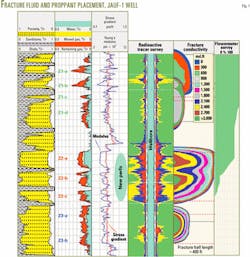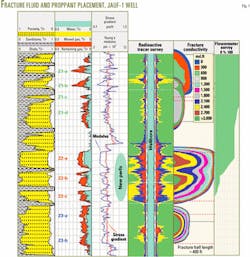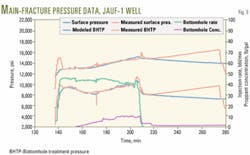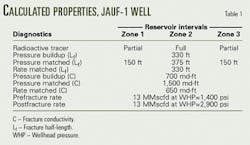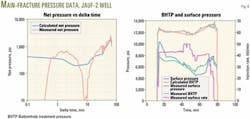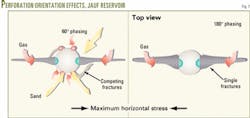Diagnostics evaluate fracture effectiveness in Saudi Arabia's Jauf reservoir
Based on a presentation to the 2001 Society of Petroleum Engineers Annual Technical Conference and Exhibition, Sept. 30-Oct. 3, 2001, New Orleans
Saudi Arabian Oil Co. (Saudi Aramco) has initiated a hydraulic fracturing program to enhance productivity and reduce or eliminate sand production from the unconsolidated sandstone layers in the Jauf reservoir of the Ghawar field.
This article is the second of a three-part series on Ghawar field gas well completions, which began last week. The first article covered Saudi Aramco's efforts to optimize acid fracturing in the Khuff carbonate reservoirs.
This article highlights Saudi Aramco's Jauf reservoir propped fracturing results and effectiveness. The third in the series will appear in the next few weeks and will feature Saudi Aramco's work to equip gas wells with tubing and wellbore equipment to enable high pressure hydraulic fracturing.
The Jauf wells have responded favorably to the stimulations and have yielded encouraging results. Once additional data are available, the company must analyze long-term production data to determine reservoir boundaries, verify continuity, and determine sustained production rates of the wells.
Saudi Aramco conducts diagnostic tests and performance evaluations on its wells before, during, and after fracturing treatments to monitor effectiveness.
The tests and evaluations include pressure-transient analysis, radioactive tracer log runs after the minifracture and main-fracture treatments, production tests, temperature and production logging, reservoir characterization, and history matching of actual fracture treatment data.
Such tests and analyses help determine fracture dimensions, incremental production, and assess fracturing success. The tests also aid in calibrating stress and fracture models for optimizing future fracture designs.
Saudi Aramco's research and development center determines the geomechanical properties of core samples under in situ conditions. The results are in turn used to calibrate openhole log derived results, which continually improve as additional cores from different depths and varying lithologies become available.
Along with temperature surveys, the company employs radioactive tracers and tracer logs to detect fluid and proppant invasion near the wellbore. These surveys yield reasonable estimates of the minimum fracture height, provided no significant fracture-angle deviations to the wellbore exist.
Pressure transient tests have provided useful information about effective reservoir and fracture properties. Engineers have used the results in their numerical simulators for production forecasting, however, long-term production testing is required to detect stabilization and compute the correct fracture parameters.
Good history matching of fracture pressure provides estimations of fracture geometry, leakoff coefficients, fracture opening and closure pressures, and near wellbore pressure drop. Engineers also use the data to calibrate mechanical models for predicting rock properties.
Jauf reservoir
The Jauf reservoir is a deep sequence of sandstone and shale saturated with condensate-rich gas. The formation exhibits large variations in permeability and porosity, with wellbores often encountering high permeability and porosity layers.
The high permeability layers have excellent flow capacity, but generally consist of softer or less consolidated sandstone, which increases the risks of sand production.
Reservoir fluid variations indicate compartmentalization, with 3D seismic interpretation indicating high degrees of faulting.1 2
The reservoir is deep, with an initial pressure of 8,750 psi and temperature of 300° F., with fluid gradients on the order of 0.15 psi/ft.
Hydraulic propped fracturing without the use of screens in the completions has proven to enhance gas productivity and reduce or eliminate sand production.3
Vertical and lateral variations of reservoir properties and unconsolidated zones have made the Jauf reservoir development quite challenging to reservoir and production engineers.
The company has tried various types of completions and production techniques to optimize hydrocarbon recovery and reduce sand production problems.
Some of the methods Saudi Aramco has employed for stimulation optimization include selectively perforating competent intervals, limiting the perforation interval length or height, limited entry treatments, oriented perforations, tip screen-outs, and frac-and-pack treatments.
Crews have opened wells gradually during flowback, testing, and production periods to establish maximum sand-free rates.
In its efforts to calculate fracture dimensions and ensure optimal treatments, the company has employed different tests and measurements such as radioactive tracer surveys, temperature logs, production and pressure transient tests, and fracture pressure history match calculations.4
Fracture mechanics
Hydraulic fracturing occurs when hydraulic pressure in the wellbore overcomes the in situ minimal horizontal stress and initiates a fracture perpendicular to the direction of the minimal stress.
Fractures are usually considered near vertical, and thus a fracture's vertical plane theoretically aligns with the wellbore.
With slight deviation of the wellbore, however, the fracture that was created leaves the wellbore plane and detection of vertical extent of the fracture becomes difficult.
The dimensions of vertical fractures depend on the geomechanical properties of the formation and excess pressure generated within the fracture.
Engineers calculate the geomechanical properties from openhole sonic logs, which they calibrate from laboratory-derived rock properties taken from cores under in situ conditions.
Fracture effectiveness depends on proppant placement. High stress differences or contrast between the fracture-initiation interval and intervals either above or below restricts the fracture's vertical growth.
Both lateral and vertical fracture growth depends on geomechanical properties, mainly in situ stress and modulus, net pressure, injection rate, pumped fluid characteristics such as viscosity, and the completion technique.
Indeed, the location or placement of the perforations impacts fracture growth and geometry; a successful stimulation treatment requires careful selection of the perforation intervals.5
The industry employs different methods for calculating fracture dimensions and properties. Since all of the approaches are approximate, a combination of methods generates the best answers, allowing one method to provide a cross check with other information.
Saudi Aramco uses various methods to calibrate mechanical properties and applies different diagnostic measurements to determine fracture dimensions and effectiveness of the propped fracture stimulations performed in the Jauf sandstone.
Geomechanical properties
The company calibrates or compares log derived geomechanical properties of Young's modulus and Poisson's ratio with core data measured in the laboratory under in situ conditions.4
Engineers employ a mathematical model to calculate in situ stress profiles under reservoir conditions.6 Once calibrated, the model predicts formation mechanical properties that in turn feed into the fracturing model.
Radioactive tracers identify the minimum vertical fracture growth and extent of proppant propagation during fracturing.
Technicians introduce several different isotopes throughout the treatments, spread into different pumping stages. Post-treatment tracer log readings indicate whether individual isotopes cover particular layers, vertically.
Engineers consider the vertical height determined by radioactive tracer to be the minimum fracture height. The tracer logs may not detect any deviations of the fracture that may exist, away from the wellbore.7
The industry uses temperature logging, similar to radioactive tracers, to determine the approximate fracture height or vertical fluid invasion, caused by cooling effects of the injected fluid on the formation.
Different lithologic layers absorb fluids differently, which can impact the temperature readings within the fractured interval.
This phenomenon requires expertise in reading and interpreting temperature logs to separate these lithologic effects.
Running temperature logs after minifracture treatments ensures or verifies whether proper vertical coverage will occur during the main treatment.
Crews must run temperature logs quickly after pumping a treatment to ensure valid readings before the formation heats the injected fluid. Saudi Aramco often performs multiple runs to ensure reading quality.
Production logging
Production logging indicates the flow contribution from multiple reservoir intervals, which may be perforated and producing.
Production logs are particularly useful for thick, multilayer reservoirs where the layers have comparable flow capacities and are separated by non-producing zones such as shale.
For such a layered system, which is not damaged or stimulated, the log will correlate to the permeability-thickness product (kh) of the layers.
Production logs should indicate whether zones are damaged or stimulated from flow responses, if the flow rates are not directly proportional to layer kh values. Partially perforated formation intervals prevent the logs from detecting individual layer contributions.
An important point to consider is that production logging conducted for multi-layer heterogeneous formations at early stages of well production will change during the life of the well.
This occurs when higher kh layers dominate the flow pattern initially, with high reservoir pressure and low draw down conditions. Lower kh layers may not contribute significantly to initial production.
Production logs conducted later in the life of the well, however, may indicate a higher percentage of flow contribution from low kh layers than the original production log reading. This is due to the reservoir depletion contrast between layers, which result from permeability differences from one layer to the next.
It is therefore important not to draw final conclusions on the effectiveness of fracturing or perforations based on intervals that may not contribute to production at the onset of well life because of their low kh values.
Pressure match
Saudi Aramco uses a 3D hydraulic fracturing model to match the actual pressure data from minifracture treatments to compute leakoff coefficients, fracture initiation, and closure pressures, and to calibrate the in situ stress distribution.6 8
Minifracture analysis also provides the near wellbore friction pressure loss from the step-down tests, which is useful to determine if the operator must add perforations to reduce friction pressure before the main fracture stimulation job.
The model matches the main-fracture pressure and rate data to compute fracture dimensions, with use of the parameters determined in the minifracture analysis.
With the minifracture match properties held constant, the model introduces the friction loss in the fracture due to proppant, fracture-roughness effects, and viscosity increase due to the presence of proppant in the fracturing fluid.
Due to damage caused by water and polymer injected during fracturing, the results calculated from pressure history match do not usually yield effective fracture dimensions. The effective fracture dimensions are usually less than what are calculated by history matching.
Pressure transient tests
Prefracture pressure transient tests allow engineers to have an average estimate of the reservoir flow capacity (kh), which is used in designing a fracture treatment and posttreatment evaluation.
Postfracture testing will provide effective fracture dimensions and fracture flow capacity (wkf). For moderate to high permeability intervals, the well achieves radial flow quickly thus providing kh from postfrac tests, without much long-term flow or shut-in period.
The authors highly recommend pressure transient testing for proper evaluation of reservoir and fracture properties.9
Saudi Aramco does not conduct prefracture transient analysis, because perforated intervals selected may or may not communicate with other productive layers prior to fracturing.
The company uses openhole drillstem tests (DSTs), cores, and log data to determine layer properties for use in fracture design.
Several examples from Saudi Aramco wells are available of fracture stimulation design using logs, tracers, pressure and production data, as well as final job execution, well completion, and production.
Jauf-1 stimulation
Fig. 1 presents the mechanical and reservoir properties of the Jauf-1 well example, with the formation lithology shown in the left column and porosity profile and mechanical properties in the next two columns.
Reservoir engineers divided the Jauf reservoir into three sections or zones labeled Z1, Z2, and Z3, for flow performance calculation (Fig. 1).
In total, the intervals of Zone 1 have a net reservoir thickness of 53 ft, porosity ranging 5-11%, and permeability in the range 0.15-0.3 md.
Zone 2 intervals have a net reservoir thickness of 60 ft, porosity in the range 12-18%, and permeability in the range 0.4-0.8 md.
Zone 3 intervals have a net reservoir thickness of 60 ft, porosity in the range 9-13%, and permeability in the range 0.2-0.4 md.
At the very beginning of the fracturing campaign, the company perforated all of these sections; however, the perforation diameters were small and had been shot at 0° phasing.
Prior to fracturing stimulation, engineers reperforated the well, adding an 80-ft interval in the Zone-2 section at 60° phasing and 6 shots/ft, as indicated by "New perfs" in the mechanical properties column of the log (Fig. 1).
Crews performed a propped fracture stimulation on the well, with 500,000 lb of 20-40 intermediate strength proppant, pumped in less than 1 hr at a rate of 40-45 bbl/min.
Figs. 2 and 3 present the history match of minifracture and main-fracture treatments.8
Fig. 4 illustrates the tip screen-out the well experienced and the proppant packing that occurred in the fracture during the main fracture treatment as indicated by the sharp net pressure increase observed on the log-log plot.
Fracture evaluation
Fig. 1 presents the fracture geometry obtained from history matching the main-fracture pressure data, assuming that all of the new and some of the old perforations were open during pumping.
The new perforations in Zone 2 would have dominated the injection behavior because of their size and density. Much of the fracture fluid and proppant invasion is believed to have taken place in the Zone 2 section.
A pressure transient test conducted on the Jauf-1 well indicated a fracture half-length of 330 ft, a net pay section of 80 ft, and a permeability of 0.33 md, which is consistent with results obtained from the fracture pressure match.
Technicians ran a combination of three radioactive isotopes, Iridium, Antimony, and Scandium, with the pad, low-proppant concentration, and high-proppant concentration fluid stages, respectively.
Fig. 1 also presents the postjob radioactive tracer log results in the center column, showing the distribution of the tracers in the well. The tracer log indicates that most of the fracture fluid and proppant invaded Zone 2.
The high proppant-concentration fluid invaded Zone 3 only slightly and Zone 1 very little, as the log indicates.
The fracture geometry obtained from history matching actual pressure data also shows dominant fracture growth in the Zone-2 section, although fracture was created in both Zone-1 and Zone-3 intervals.
Fig. 1 shows a prefracture flowmeter survey, presented in the far right column, indicating that more than 80% of the production was from the upper Zone-2 interval, with about 15% from Zone 1. No contribution was observed from Zone 3.
A postfracture flowmeter survey indicates a similar production contribution from the different Jauf intervals; most of the production, however, was attributed to the lower Zone-2 interval.
Engineers used the calculated fracture properties to history match postfracture well performance, however, with limited data, as the well flowed for only a 2-week period.
Although the model yielded a good match, future predictions using short-term production data may not be reliable. Engineers will fine-tune the reservoir model once the well is put on production and long-term production data becomes available.
Based on the analyses performed, the company has concluded that an effective propped fracture was created in Zone 2, which was confirmed by the production log and radioactive tracer survey.
Because of radioactive tracer short radius of investigation, the tracer survey log may not detect behind pipe fracturing or fracture growth associated with slightly inclined fractures.
Table 1 summarizes the Jauf-1 well fracture stimulation results. At the same production rate, the well gained 1,500 psi flowing wellhead pressure from the fracture stimulation job. Various diagnostic tests and performance evaluation of the well have yielded consistent results.
Jauf-2 well example
For the Jauf-2 well completion, engineers focused on minimizing the potential for sand production problems, in addition to stimulating the well.
As a result, the company perforated only 30 ft of the over 100 ft of net pay interval. Engineers had selected the 30 ft interval that was perforated, because it was a consolidated section of the reservoir with a relatively higher Young's modulus (Fig. 5).
The fracture design run indicated that this perforated interval would yield a fracture height that would cover all gas bearing pay zones vertically, leaving no potential productive intervals behind pipe without a flow path to the wellbore.
Crews performed a propped fracture stimulation on the well, with 280,000 lb of 20-40 intermediate strength proppant combined with 20-40 resin coated proppant for sand control, pumped in less than 1 hr at a rate of 40-50 bbl/min.
Fig. 5 presents the fracture geometry obtained from the fracture pressure match. One should note that the fracture growth was significantly upwards into the higher quality portions of the Jauf reservoir.
Postfracturing temperature survey and radioactive tracer log both confirmed that the fracture migrated upward, from the relatively short perforated interval (Fig. 5).
Fig. 6 presents the bottomhole, surface, and net pressure match for the fracture treatment. The job achieved a 200 ft fracture half-length from the pumping pressure match.
Postfracture pressure transient analysis and production history match yielded similar results, with permeability thickness values of 500-700 md-ft and fracture conductivities of 600-2,000 md-ft.
Oriented Perforations
Saudi Aramco has adopted the practice of perforating both the Khuff carbonate and Jauf sandstone reservoirs at 6 shots/ft and 180° phasing, in the direction of maximum horizontal stress.
This reduces near wellbore, friction-pressure drop during fracturing and provides the fracture fluids and proppant an easier path to initiate, propagate, and etch or prop the fracture.
Fig. 7 presents a schematic diagram comparing the previous 60° phased perforations to the current 180° phased and oriented perforating scheme, particularly as the benefits relate to sandstone reservoirs.
Oriented perforations provide better proppant packing near the wellbore, reduce the chances of generating multiple competing fractures, and assure less sand production from unconsolidated formations.
Fig. 8 presents calculations for near wellbore pressure drop during injection for two wells, one with conventional 60° phasing and the other with 180° oriented perforations.
One readily notices the percent pressure gain from the 180° phased perforations oriented in the direction of maximum horizontal stress.
Productivity
The company normally does not perform prefracture production tests for the Jauf wells that would be completed screenless and with limited perforation interval.
Normally, the engineers do not select perforations in the best sections of the formation and do not perforate the wells throughout the entire pay thickness.
Perforations are generally of short intervals and in sections where the formation rock is relatively competent, usually in the low porosity and higher stress intervals, which is designed to prevent sand production from the unconsolidated portions of the reservoir.
In general, the short-term production data collected and analyzed from the Jauf reservoir indicates successful stimulation treatments from many wells, with postfracture stimulation production rates in the range 10-45 MMscfd at flowing wellhead pressures ranging 2,150-5,000 psi.
The company obtained these results with propped fracture stimulations ranging in job size up to 500,000 lb of proppant.
Saudi Aramco plans further long-term production testing, monitoring, and analysis of the wells.
Parallel to screenless completions, Saudi Aramco has recently initiated screened, frac and pack proppant treatments in the highly unconsolidated reservoir sections.
This will allow the company to deal with much softer formations, prevent proppant and formation sand flowback, and communicate with the reservoir directly by perforating all sand intervals that have the potential to produce gas.
References
- Al-Qahtani, M.Y. and Buhidma, I., "Improved Near-Well Reservoir Characterization of a Complex Gas Condensate Reservoir in Saudi Arabia by Integrating Core, Log, Seismic, and Extended Well Test Data," SPE 68140, presented in the Middle East Oil Show, Bahrain, March 2001.
- Liu, J.S., Wilkins, J.R., Al-Qahtani, M.Y., and Al-Awami A.A., "Modeling a Rich Gas Condensate Reservoir With Composition Grading and Faults," SPE 68178, presented in the Middle East Oil Show, Bahrain, March 2001.
- Rahim, Z., Al-Qahtani, M.Y., and Buhidma, I., "Improved Gas Recovery From Acid or Hydraulic Fracturing," Saudi Aramco Journal of Technology, Spring 2000.
- Saudi Aramco gas reservoir management division and research and development center, internal documentations and laboratory studies.
- Rahim, Z. and Al-Qahtani, M.Y., "Selecting Perforation Intervals and Stimulation Technique in the Khuff Reservoir for Improved and Economic Gas Recovery," SPE 68216, presented in the Middle East Oil Show, Bahrain, March 2001.
- Al-Qahtani, M.Y. and Rahim, Z., "A Mathematical Algorithm for Modeling Geomechanical Rock Properties of the Khuff and Pre-Khuff Reservoirs in the Ghawar Field," SPE 68194, presented in the Middle East Oil Show, Bahrain, March 2001.
- Holditch, S.A., Holcomb, D., and Rahim, Z., "Using Tracers to Evaluate Propped Fracture Width," SPE 26922, presented at the Eastern Regional Conference, Pittsburgh, PA, Nov. 2-4, 1993.
- Meyer & Associates, Natrona Heights, PA., "MFrac-III, a 3D acid and hydraulic fracturing simulator," version 4.01.
- Saphir Advanced: Pressure Transient Test Design and Analysis Model, v 3.01.03, Kappa, Paris, France.
